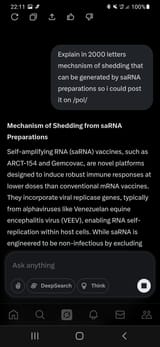Search Results
7/5/2025, 10:13:51 PM
1. RNA Release via Exosomes or Cell Death
saRNA’s self-replication produces high levels of RNA and encoded antigens (e.g., spike protein) in host cells, primarily muscle cells and antigen-presenting cells at the injection site. This prolonged activity (30–60 days vs. 3–5 days for mRNA) increases RNA and protein production. Cells undergoing stress, apoptosis, or necrosis due to saRNA’s immune activation or lipid nanoparticle (LNP) toxicity may release these molecules. Exosomes—small vesicles secreted by cells—can encapsulate saRNA, its replication intermediates (e.g., double-stranded RNA), or antigens, potentially transferring them to nearby cells or bodily fluids (e.g., saliva, sweat). This could allow uptake by unvaccinated individuals’ cells, though without replicase, amplification would be limited.
2. Biodistribution and Systemic Spread
Preclinical studies show saRNA and LNPs distribute beyond the injection site to organs like the spleen, liver, and lymph nodes, with transient presence in blood. If saRNA or antigens reach mucosal surfaces (e.g., respiratory tract), they could be excreted in aerosols or secretions, enabling environmental shedding. The amplified RNA load increases this risk compared to mRNA vaccines.
3. Theoretical Recombination
saRNA’s alphavirus-derived replicase could, in rare cases, recombine with co-infecting RNA viruses in vaccinated individuals, potentially forming replication-competent hybrids. While saRNA lacks structural genes, such recombination could produce transmissible particles, though no evidence confirms this.
4. Immune-Mediated Shedding
saRNA’s strong immune activation (via dsRNA and innate sensors like RIG-I) may lead to cell turnover, releasing RNA or antigens into extracellular spaces, potentially detectable in bodily fluids.
saRNA’s self-replication produces high levels of RNA and encoded antigens (e.g., spike protein) in host cells, primarily muscle cells and antigen-presenting cells at the injection site. This prolonged activity (30–60 days vs. 3–5 days for mRNA) increases RNA and protein production. Cells undergoing stress, apoptosis, or necrosis due to saRNA’s immune activation or lipid nanoparticle (LNP) toxicity may release these molecules. Exosomes—small vesicles secreted by cells—can encapsulate saRNA, its replication intermediates (e.g., double-stranded RNA), or antigens, potentially transferring them to nearby cells or bodily fluids (e.g., saliva, sweat). This could allow uptake by unvaccinated individuals’ cells, though without replicase, amplification would be limited.
2. Biodistribution and Systemic Spread
Preclinical studies show saRNA and LNPs distribute beyond the injection site to organs like the spleen, liver, and lymph nodes, with transient presence in blood. If saRNA or antigens reach mucosal surfaces (e.g., respiratory tract), they could be excreted in aerosols or secretions, enabling environmental shedding. The amplified RNA load increases this risk compared to mRNA vaccines.
3. Theoretical Recombination
saRNA’s alphavirus-derived replicase could, in rare cases, recombine with co-infecting RNA viruses in vaccinated individuals, potentially forming replication-competent hybrids. While saRNA lacks structural genes, such recombination could produce transmissible particles, though no evidence confirms this.
4. Immune-Mediated Shedding
saRNA’s strong immune activation (via dsRNA and innate sensors like RIG-I) may lead to cell turnover, releasing RNA or antigens into extracellular spaces, potentially detectable in bodily fluids.
Page 1
